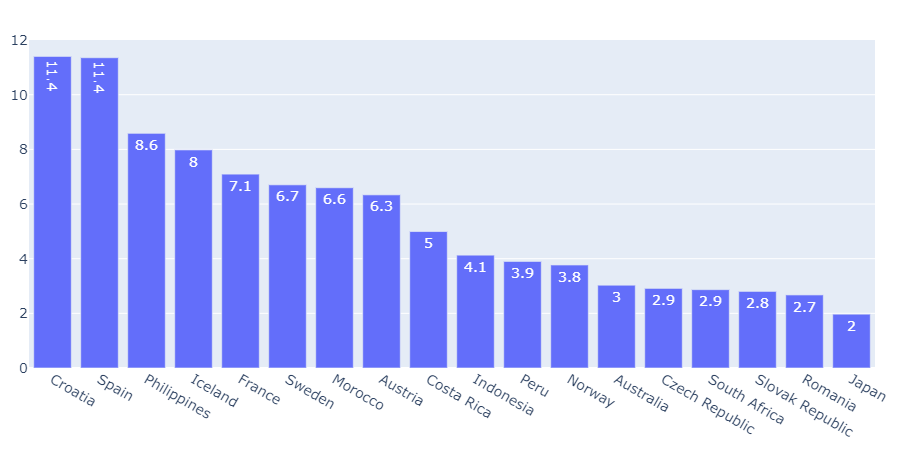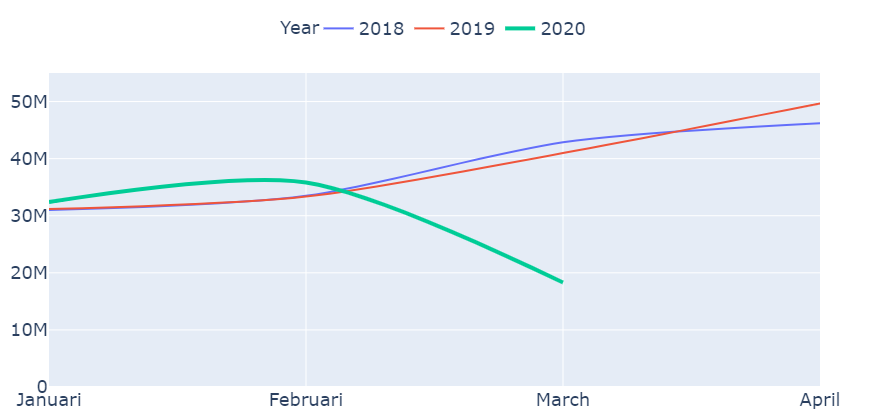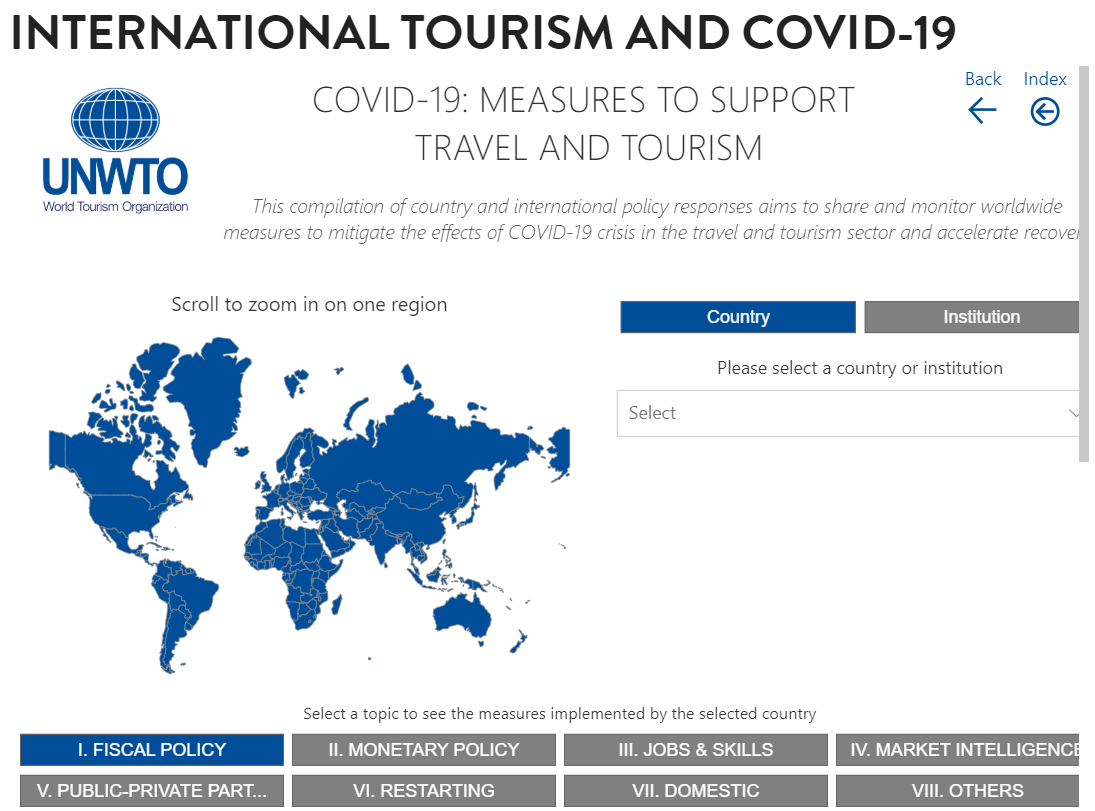The Impact of COVID-19 on the International Tourism Industry
The current COVID-19 crisis has led to national quarantines and global travel bans, bringing international travel to a standstill. These measures are expected to have a long lasting and destructive effect on international tourism. In this data story, our editorial team discusses the importance of the tourism industry to national economies, the impact that COVID-19 will most likely have, and the national and European measures that are implemented to mitigate the effect of the economic crisis.
The current COVID-19 crisis has led to national quarantines and global travel bans, bringing international travel to a standstill. According to a research performed by the United Nations World Tourism Organisation (UNWTO), 100% of UNWTO countries impose restrictions on travelling and 72% have completely closed their borders to international tourism. The exact travel restrictions per country can be found in a global dashboard created by the Humanitarian Data Exchange (HDX) using data from the World Food Programme (WFP). With the cancellation of business trips, holidays, and weekend getaways, the tourism industry is thus heavily impacted by the COVID-19 crisis.
The travel restrictions affect hotels, camping sites or other types of accommodation, but also restaurants, museums, and other activities frequented by local as well as international tourists alike. The pandemic is also expected to have a longer lasting effect on international tourism, while other economic sectors might recover more swiftly. Especially for countries where the national economy relies heavily on the tourism industry, it is crucial to closely monitor the situation and provide measures to protect the industry and mitigate the economic impact of this crisis.
In this data story we take a closer look at available data and data-related initiatives that help us get insights into the contribution of tourism to the national economies of European countries, consider the effects of the decrease in international tourism, and examine the measures taken by countries to support the sectors.
The tourism industry as part of national economies
According to the World Travel & Tourism Council (WTTC) tourism generates 10,3% of global GDP, making it an important driver of the global economy. For countries such as Spain and Italy the contribution of tourism to their GDP is even higher than the global average, 14,3% and 13,0% of their GDP in 2019, respectively. Using 2018 data from the Organisation for Economic Co-operation and Development (OECD), the chart in figure 1 shows another assessment of the contribution of tourism to national GDP in the pre-crisis situation for the available countries.

Figure 1: Chart on percentage of GDP contributed by tourism, source: OECD
Tourism is also one of the most labour-intensive sectors of our economies. According to the WTTC, tourism supports 330 million jobs worldwide, which are at risk in the current situation. To create a better understanding of the number of people working in the tourism industry, the European Data Portal created a visual (see figure 2) based on 2019 data from Eurostat. The figure shows information on the percentage of the active population working in tourism-related sectors.

Figure 2: European overview of percentage of population employed in tourism-related sectors, source: Eurostat
Tourism decrease caused by COVID-19
Travel bans make tourism one of the industries that is hit the hardest by the COVID-19 crisis. In Europe, several countries already show that the number of nights spent in tourist accommodation was halved in March 2020 compared to previous years. This is visualised for the available countries by the European Data Portal in figure 3, which was created based on data from Eurostat.

Figure 3: The number of nights spend at tourist accommodation in the first 3-4 months of 2018-2020, source: Eurostat. Note: The available European countries are Denmark, Finland, Hungary, Iceland, Norway, Serbia, Spain, and Sweden.
The UNWTO is the United Nations agency that oversees the promotion of responsible, sustainable and universally accessible tourism. They published a summary of their World Tourism Barometer in May 2020 with a special focus on the impact of COVID-19 on the tourism industry. To get a clear overview of the content and visualisations a dashboard was created, where, among other subjects, the impact of COVID-19 on the tourism industry is assessed, highlighting the most vulnerable destinations, and comparing impact vs past crises in the sector. In the first quarter of 2020, international tourism already decreased by 22%, with a decline of 57% in March. Creating a forecast for the rest of 2020 is complex due to the rapidly changing circumstances, but the UNWTO plotted three scenarios depending on the course of the virus and the duration of the travel restrictions and estimated a possible drop in international tourist arrivals between 58% and 78% in 2020. The effect of the scenarios on international tourism can be seen in figure 4.

Figure 4: Three scenarios created by the UNWTO about the effect on international tourism.
The Word Travel & Tourism Council (WTTC) represents the private sector of travel and tourism. They state that their mission is to ensure the sector is seamless, secure, safe, inclusive, and sustainable. The WTTC also conducted a research to assess the impact of COVID-19 on the travel and tourism industry. They conclude that the industry will lose 2.7 trillion USD in 2020, and that millions of jobs are compromised by the crisis. Currently, estimates are that the Asia-Pacific region will be most heavily impacted with 63.4 million job losses. For Europe, their research suggests that 13 million jobs in the travel and tourism sector will be lost, resulting in a tourism GDP loss of €633 billion[1].
Measures to mitigate impact on tourism sector
To mitigate the economic impact of this crisis and to protect the tourism industry, governments and institutions are already taking several measures. The European Parliament clearly summarised the measures taken at national and European level to support the industry. Although the European Commission (EC) has limited authority to intervene in the industry since it can only support, coordinate, or supplement Member States' actions in this area, a set of responses to the COVID-19 outbreak to support both at European and on national level has been defined. Among other things, the EC offers legal analyses to Member States and created a network of industry associations to facilitate their sharing of experience. The EC also reserved €37 billion for the Coronavirus Response Investment Initiative to provide liquidity for businesses and support people who lost their job.
When looking at national levels, we see that most EU Member States already announced measures to support the economy, including the tourism industry. For more information on financial measures in general see one of our previous data stories. The measures include tax moratoriums, extended deadlines for payments, as well as wage subsidies, loans, and guarantees for workers. To illustrate these measures, an interactive dashboard created by UNWTO shows per country and per institution the taken measures, which can be seen in figure 5.

Figure 5: Screenshot of UNWTO’s dashboard on measures to protect and support the travel and tourism industry.
Tourism during and beyond the COVID-19 crisis
Recently some European countries, such as Italy and Spain, announced that they will reopen the borders and restart tourism shortly. To help the tourism industry restart after months of lockdown, the European Commission presented a package of guidelines and recommendations to help Member States to gradually lift travel restrictions and allow businesses to reopen. During the process of easing the restrictions it is important to ensure safety for all travellers and take the necessary health precautions. Overall, Member States should keep in mind the epidemiological situation in other Member States, provide proper containment measures throughout the whole journey, and consider economic and/or social prioritisation of cross-border movements in key areas.
However, we are currently in the middle of the crisis, making the prediction for the future of the industry difficult. The managing director at the WTTC believes that it could take up to 10 months for the tourism sector to recover once the virus is under control. Will things permanently change regarding the amount and the way we travel? At what speed can restrictions be eased while ensuring safety at all time? Can the restrictions only be completely lifted once a vaccine is created or will we find a solution in the meantime? These are all examples of questions policy makers are facing today. In the meantime, we can make use of the opportunity to explore our own countries’ touristic offerings and support local tourism.
Looking for more open data related news? Visit the EDP news archive and follow us on Twitter, Facebook or LinkedIn.
[1] Exchange rates as of 02 January 2020.
